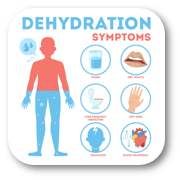Even the most avid athletes can struggle to stay motivated to workout during the winter months. With fewer daylight hours and chilly temperatures, you may decide to settle in for a long winter of boring treadmill runs. However, with appropriate planning, exercising outside during cold weather is still doable and safe.

When cold weather arrives, it is important to take a few extra steps to ensure you are staying safe during an outdoor winter workout.
Step 1: Choose Appropriate Clothing:

- Layering clothing is important to add insulation and prevent body heat from
- escaping.
- Base Layer: Moisture-wicking material
- Middle Layer: Fleece material for warmth
- Outside Layer: Thin waterproof material
- Wear gloves, hat, headband, scarf
- Extremities will be most affected by low temperatures because blood is moving towards the truck to keep vitals normal
- Remove if you feel yourself getting too hot
Step 2: Perform Warm-Ups
Cold weather can make your muscles feel stiff or tight. Warming up before exercise brings muscles to their working temperatures by increasing blood flow.
- Choose warm-ups that mimic the exercise being performed to prepare the body for exercise such as a walk or Rapid Warm-Up
- Upper body: Arm circles, shoulder squeezes, or overhead reaches
- Lower body: Hip swings, bodyweight squats, or knee hugs
- Start slow and increase range of motion as you get warmer.
Step 3: Stay Hydrated

No matter the weather, it is always important to stay hydrated during a workout. Since cold, you may not reach for the water bottle as frequently as you do during warm-weather workouts, but water is excreted through sweat and breathe so it is critical to drink while exercising outside.
Part of keeping your body hydrated includes keeping a balance of electrolytes. Electrolytes are minerals that carry an electrical charge when dissolved in water. Sodium, potassium, and calcium are some you may be familiar with. Part of keeping your body hydrated includes keeping the balance of electrolytes. If there is an imbalance, it can lead to muscle cramps, headaches, or fatigue.
Step 4: Protect Your Skin
Winter weather can be tough on the skin. Cold temperatures and low humidity levels create dry air that pulls moisture away from the skin. Harsh winds can exacerbate the problem when working out outside. When temperatures are cold, ramp up your skincare routine to keep your skin healthy and hydrated.
Tips for Protecting Your Skin:
- Moisturize Daily: Petroleum or cream-based moisturizers are better than lotion for dry skin. Apply moisturizer directly to wet skin after bathing to trap surface moisture.
- Use the Right Soap: Use non-irritating, non-detergent-based cleanser and apply moisturizer immediately after.
- Protect from Wind: Use a hat and gloves to protect your face and hands.
- Avoid Extreme Cold: When the temperatures are below zero, avoid working out outside. Cold temps can cause skin disorders and frostbite.
- Block Winter Sun: Use SPF 30 year-round and reapply as needed.
Following these steps can help you safely – and enjoyable – exercise outside when temperatures drop. Make sure to monitor how your body feels to prevent injuries such as muscle strains, frostbite, and windburn.